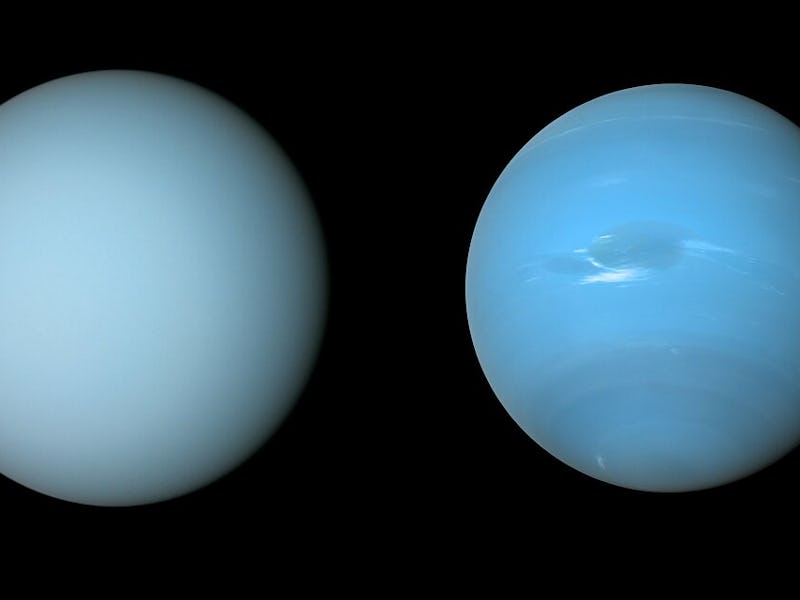Why are Uranus and Neptune different colors? The answer is surprisingly mundane
G’damn weather.

Way back in the late 1980s, the Voyager 2 spacecraft visited Uranus and Neptune. During the flybys, we got to see the first close-up views of those ice giants. Even then, planetary scientists noticed a marked color difference between the two. Yes, they both sport shades of blue. But, if you look closely at Uranus, you see a featureless pale blue planet. Neptune, on the other hand, boasts interesting clouds, dark banding, and dark spots that come and go. They’re all set against a darker blue backdrop.
So, why the difference? Planetary scientists have long suspected aerosols (droplets of gas that have liquids or dust suspended in them) in each atmosphere. But, according to a team of scientists studying the layers of the planets, the hazes those aerosols create may only be part of the story.
Uranus and Neptune: The Big Picture
Voyager 2’s observations of Uranus, and a false-color image of the planet.
To understand what’s happening, let’s look at what we know about Uranus and Neptune. They’re called “ice giants” because their cores have high proportions of oxygen, carbon, nitrogen, and sulfur. Those elements are called “ices” because they are volatile chemical compounds that freeze right around 100 K. However, the clue to the different colors lies in the planets’ atmospheres. Each has hydrogen, helium, and methane as its main components. These blankets of gases are where each planet’s “weather” occurs. It turns out you need a lot of observations—both visually and in other wavelengths of light—over long periods of time to watch weather play out in these two worlds.
Voyager gave astronomers a taste of what’s “out there.” That led to more long-term observations using other ground-based and space-based observatories. Those studies reveal details about the weather in those worlds and what it does specifically to turn Uranus so pale.
Neptune, as imaged by Voyager.
Why so blue on Neptune and not so blue on Uranus? Hazes. But, scientists needed to explain the existence and activity of hazes in the upper atmospheres of giant ice planets. So, they created a model. The work was done by a team led by Patrick Irwin, Professor of Planetary Physics at Oxford University in England.
Their model actually uses observations of multiple atmospheric layers on Uranus and Neptune.
“This is the first model to simultaneously fit observations of reflected sunlight from ultraviolet to near-infrared wavelengths,” explains Irwin in a press release statement. He is the lead author of a paper presenting the team’s model in an upcoming issue of the Journal of Geophysical Research: Planets.
“It’s also the first to explain the difference in visible color between Uranus and Neptune.”
Irwin’s team analyzed a set of observations of both planets in ultraviolet, visible, and near-infrared wavelengths (from 0.3 to 2.5 micrometers). The data came from the Near-Infrared Integral Field Spectrometer (NIFS) on the Gemini North telescope (part of the NOIRLab) as well as archival data from the NASA Infrared Telescope Facility. Images and data from the NASA/ESA Hubble Space Telescope also contributed to the study. Together the data revealed surprising structure and activity in both atmospheres.
Blue Planets
The resulting model reveals striking differences between two worlds that otherwise look fairly similar. If we look at each planet in visible light, of course, we see the different shades of blue. The infrared and other data go deeper and reveal details about haze layers. The team’s model shows three layers of aerosols at different heights in the atmosphere. The layer that affects the colors is the middle layer, which is thick with haze particles and is called the Aerosol-2 layer. Both planets have that layer, but it’s the one that appears thicker on Uranus than on Neptune.
The Cause and Effect of Hazes on Uranus and Neptune:
This diagram shows three layers of aerosols in the atmospheres of Uranus and Neptune, as modeled by a team of scientists led by Patrick Irwin. The height scale on the diagram represents the pressure above 10 bar. The deepest layer (the Aerosol-1 layer) is thick and composed of a mixture of hydrogen sulfide ice and particles produced by the interaction of the planets’ atmospheres with sunlight. The key layer that affects the colors is the middle layer, which is a layer of haze particles (referred to in the paper as the Aerosol-2 layer) that is thicker on Uranus than on Neptune. Above both of these layers is an extended layer of haze (the Aerosol-3 layer) similar to the layer below it but more tenuous. On Neptune, large methane ice particles also form above this layer.
Let’s look at how hazes are created on both planets. It turns out the process is roughly the same for each one. Both have outer atmospheres rich in methane, which freezes out at roughly 91 K. That methane ice condenses onto particles in the Aerosol-2 layer mentioned above, which makes the atmospheric particles slightly more massive. The result is methane “snow” that showers down onto layers below. It actually seems like a case of “constant winter” at certain levels of each atmosphere.
However, there’s a final twist that explains the color differences between the two planets. Neptune has an active, turbulent atmosphere. That churns up the methane “snow” particles and sends more of the snow and haze deeper into the atmosphere. Thus, Neptune “grooms itself,” has a thinner haze layer, and gets to keep its pretty blue color. That same churning may also explain the dark spots on the planet.
Uranus, on the other hand, has a more sluggish atmosphere. Not as much churning of the methane “snow” goes on there, and the haze particles aren’t pulled downward. That means the haze layer persists and is thicker, providing a lighter shade of pale blue on Uranus.
This article was originally published on Universe Today by Carolyn Collins Petersen. Read the original article here.
This article was originally published on